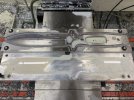- Joined
- Dec 30, 2002
- Messages
- 1,242
Disclaimer: I have never made a knife but I do have 15 years CAD/CAM and machining experience.
I would really like to machine a fixed blade, something like a small boot knife or dagger. I'm not yet sure if I would do an integral or just make it out of flat stock and bolt on some scales but I would like to 3d machine the primary form of the blade.
Who's done this? My main concern is securing the pointy end of the knife. Obviously the handle can have holes for fixturing that will can be later covered but not the blade. How did you get around this? I have some ideas but I'd like to hear from someone who has done it.
Also, I have plenty of experience hard milling, would machining this out of heat treated stock be better than heat treat after machining?
I would really like to machine a fixed blade, something like a small boot knife or dagger. I'm not yet sure if I would do an integral or just make it out of flat stock and bolt on some scales but I would like to 3d machine the primary form of the blade.
Who's done this? My main concern is securing the pointy end of the knife. Obviously the handle can have holes for fixturing that will can be later covered but not the blade. How did you get around this? I have some ideas but I'd like to hear from someone who has done it.
Also, I have plenty of experience hard milling, would machining this out of heat treated stock be better than heat treat after machining?

